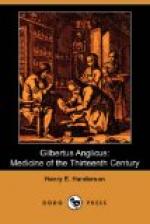On the other hand, Mr. Kingsford bases his theory of Gilbert’s sojourn in Syria upon a story adopted, I think, from Littre and found in the Histoire literaire de la France. The Compendium of Gilbert contains (f. 137a) a chapter giving the composition of a complex collyrium with which he professes to have cured the almost total blindness of Bertram, son of Hugo de Jubilet, after the disease had baffled the skill of the Saracen and Christian-Syrian physicians of his day. Now Littre avers that a certain Hugo de Jubilet was involved in an ambuscade in Syria in the year 1227, and that he had a son named Bertram. It is very natural, of course, to conclude that this Bertram was the patient recorded in the book of Gilbert. Kingsford says that Gilbert “met” Bertram in Syria, but the text of the Compendium says nothing of the locality of their meeting, which might have taken place almost anywhere in Europe, perhaps even at Salernum, a favorite resort of the invalided Crusaders in these times. Finally, Dr. Payne disposes effectually of the authenticity of the entire story by calling attention to the fact that the chapter referred to in the Compendium is marked plainly “Additio,” without indicating whether this addition is from the pen of Gilbert or some later glossator.
Finally, I may suggest another line of argument, which, so far as I know, has not yet been advanced for the determination of the period of Gilbert.
The Compendium Medicinae of Gilbert is, of course, a compendium of internal medicine. But the book is also something more. Not less than fifty chapters are devoted to a comparatively full discussion of wounds, fractures and dislocations, lithotomy, herniotomy, fistulae and the various diseases on the border line between medicine and surgery. Not a single surgical writer, however, is quoted by name. Nevertheless the major part of these surgical chapters are either literal copies, or very close paraphrases, of the similar chapters of the “Chirurgia” of Roger of Parma, a distinguished professor in Salernum and the pioneer of modern surgery. The precise period of Roger is not definitely settled by the unanimous agreement of modern historians, but in the “Epilogus” of the “Glosulae Quatuor Magistrorum” it is said that Roger’s “Chirurgia” was “in lucem et ordinem redactum” by Guido Arietinus, in the year of our Lord 1230. This date, while perhaps not unquestionable, is also adopted by De Renzi, the Italian historian of Medicine. The original MS. of Roger’s work is said to be still in existence in the Magliabechian Library in Florence, but it has never been published in its original form.[5] Roland of Parma, however, a pupil of Roger, published in 1264 what purports to be a copy of Roger’s “Chirurgia” with some notes and additions of his own, and it is from this MS. of Roland that all our copies of Roger’s work have been printed. Roger’s “Chirurgia” was popularly known as the “Rogerina;”




